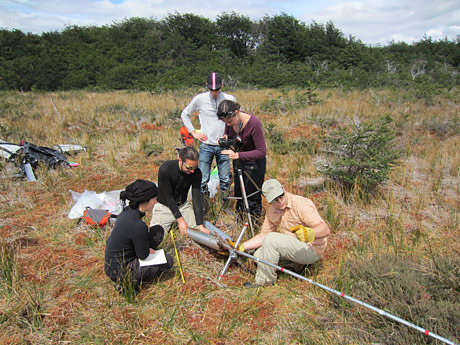Incas: The first atmosphere polluters in South America?

Led by François De Vleeschouwer of the Laboratoire Ecologie fonctionnelle et Environnement – EcoLab laboratory (CNRS / University of Toulouse), the PARAD project is based on the study of the chemistry of dust particles in peat bogs from South Chile and Argentina. Formed on average some 10,000 years ago, peat bogs are created by the accumulation of organic matter in an acidic, water-saturated, anaerobic (in absence of oxygen) environment. This highly specific composition means that the organic and plant matter contained in it decomposes very slowly. Atmospheric dust particles get trapped in the organic matter over the centuries, and are preserved thanks to the particular conditions of the peat bog. Taking core samples from the peat, which reflects the composition of the past atmospheres, enables scientists to take a journey back through time. Peat bogs can thus cover periods ranging from 10,000 to 15,000 years, depending on the sites studied.
8,000 years under close scrutiny
Patagonia and Tierra del Fuego provided the “field laboratory” for the PARAD project. The peat bogs in that region of the world were pristine of human activity before the 19th-century, when the gold and coal rushes began. Working in the Karukinka Natural Park in Chile, the team drilled down to a depth of 4.5 metres to extract a peat core containing dust particles deposited there in the course of the last 8,000 years. The metal content of the core samples was then analysed by mass spectrometry. The isotopes of lead, which represent true signatures of the origin of the metal (whether natural or resulting from human activity) were analysed in particular. This study revealed the presence of metallic elements dating back to the pre-Columbian civilisations, which started to develop and work metal around 4,000 years ago in the Northern Andes.
Reconstructing the history of winds and dust flows
In order to identify the origin of the metallic dust particles and reconstruct their journey, the PARAD team members analysed the meteorological data from the last fifty years and modelled the particle trajectory probabilities for the whole of South America. The prevailing winds in South America blow from the West, therefore they carry the majority of the particles eastwards. The studies confirmed that the majority of the trajectories do indeed run from West to East, but in 5 to 10% of the cases however, the winds may originate from the Northern Andes and blow as far south as Tierra del Fuego. The dust found in the Chilean peat bog would thus have been released into the atmosphere as a result of the activities of the pre-Columbian civilisations and the Incas in particular, who mined and emitted particles from copper, silver (and lead as a by-product), antimony and tin from the Andes until the beginning of the 16th century. Some of these particles were carried over more than 4,000 kilometres, hence their presence in Tierra del Fuego. This is the first time that a team of scientists demonstrates such long-distance transportation of metals in South America.

F. De Veeschouwer and colleagues open a peat core containing several thousands of years of information about past metal and dust deposition, climate and environment.
Photo Courtesy G. Le Roux
Find out more:
- Presentation of the project on the ANR website
- Discovery of Inca pollution in South America, presentation of the project on the CNRS website
- Publication on metals in peat bogs, on-line scientific review Plos One
- The PARAD field campaign on video (2013)
- A video detailing the breakdown of the surveys (Ecolab)
- Website of Karukinka Park
Photo: A partial view of the Karukinka peat bog complexe. Photo Courtesy J-Y De Vleeschouwer


